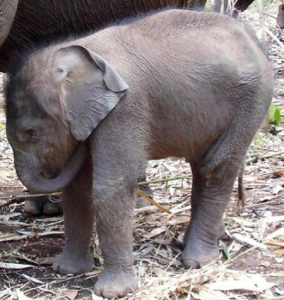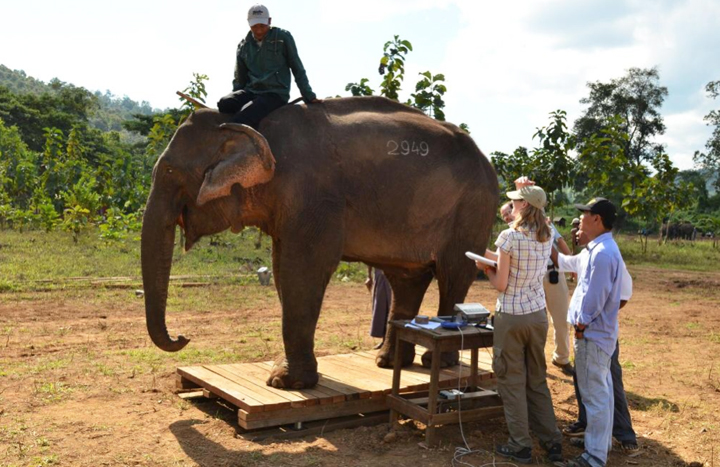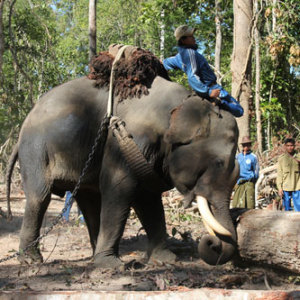The Half-Captive, Half-Wild Elephants Of Myanmar: A Quirky Road To Survival
Have Myanmar’s highly endangered Asian elephants been saved in a counter-intuitive way —in part, by keeping them employed in logging camps?
By Vicki Croke
As part of her work assessing the health of Myanmar’s working elephants, Hannah Mumby weighs San Kyi Pyu, or Number 2949. This female was caught from the wild in 1968, probably as a teenager. She had a female calf in 1988 and is now grandmother to a calf born in 2009. (Myanmar Timber Elephant Project)
As President Obama touches down in Myanmar today and many people talk of human rights and democratic reform, conservationists also see an urgent agenda: the future of elephants.
Here is a country at the crossroads, with unbelievable potential—lots of elephants and lots of forest, according to one international wildlife expert, a place that “could be one of our last opportunities for a self-sustaining wild elephant population,” according to another. And, yet, if played wrong, it could be much like many of its neighbors, with “unemployed” elephants begging on the streets and wild elephants driven to near extinction by habitat loss, poaching, and smuggling into the tourist trade.
Vicki talks with Here & Now’s Robin Young about Myanmar’s elephants:
It’s a pivotal moment in the history of Myanamar—the end of 50 years of isolation. And the advantages here and pitfalls can be surprising. Starting with the way Myanmar has ended up with the largest population of captive Asian elephants in the world, the second largest population of Asian elephants overall.
For decades, while the rest of the world modernized, Myanmar’s working elephants continued to live old-fashioned lives: As many as 5,000 of these animals still pull logs out of the forest just the way it was done a century ago.
Even if putting elephants to work seems inherently wrong to some, the practice might just have helped save them and minimized the impact on their habitat. Elephants have remained an important resource for the country.
The logging work has allowed the animals to live a half-captive, half-wild life. Their “shifts” are about five hours long, after which they are set free to forage, socialize, and even mate with wild elephants overnight. And elephants need very little sleep, so they have a lot of time to themselves. They don’t have the foot issues that plague captive elephants in zoos, for instance. And they tend to live into old age as free elephants here do.
The way the camps run has changed little since the 1920s, a period of time covered in my book “Elephant Company,” which is about a British adventurer named J.H. Williams. He worked for a teak company in what was then known as Burma where he came to love and protect the animals he managed.
He also respected the uzis, or elephant handlers, who could distinguish the tracks of their own elephants from others as they sought them out each morning.
Hannah Mumby knows this world well. She is an evolutionary ecologist with the Myanmar Timber Elephant Project, a group based at the University of Sheffield in the UK, which is focused on the working elephants. She says that even the logbooks used to record the lives of each individual working elephant still exist, providing her with a rich archive going back to the 1930s. It’s important information to an evolutionary ecologist who crunches numbers and data in order to “see clear patterns” of overall health and reproduction and to look at the future of these elephants.
A logging elephant at work in 1900. Not much has changed since then for many of the working elephants.
It’s a critical moment. Asian elephants are highly endangered. There are perhaps 50,000 left across 13 countries. So Myanmar’s elephants–5,000 in captivity, 1,000-6,000 in the wild–really count.
Mumby says, “This could be one of our last opportunities for a self-sustaining wild elephant population and the captive elephant could be a big part of that.”
But there are problems to avoid.
Logging practices are changing in Myanmar. And in places like India and Thailand, where captive elephants who once worked in logging have been replaced by construction equipment or have run out of work in deforested areas, animals are now literally begging on the streets with their mahouts, or handlers, for money and food.
“Myanmar is at a really interesting point in its history now, an exciting time to be here,” Hannah says. “And what I would personally like is to see Myanmar learning from what happened in other Southeast Asian countries.”
Tom Gray, the regional species expert for the World Wildlife Fund, agrees, and uses Vietnam as a cautionary example. “Fifty years ago [it] had a very healthy wild elephant population, and now elephants are on the brink of extinction because of poorly regulated development, poorly managed protected areas, and forest loss.”
Intelligent, deeply emotional, and highly endangered, Asian elephants still have a chance in Myanmar. (Jeffrey Parish/WWF)
WWF has just this month opened an office in Yangon. “We’re arriving at a fantastic time,” says Gray. There are still forests and still elephants in those forests. WWF is hoping to preserve habitat and to create and maintain “elephant passages in key locations.” This will be an integral part of an effort to “mitigate the impacts of some of the new road developments that are going through in southern Myanmar,” like a proposed super-highway that would cut straight across the country to Thailand.
WWF has partnered with the Wildlife Conservation Society to work on “an elephant conservation strategy for Myanmar—a national action plan for elephants.” So far, he says, the government is “listening to conservation ideas and green development ideas.”
Among their first tasks will be to better understand exactly how many elephants there are and where they are.
While a recent news headline read: “Myanmar’s timber elephants and their handlers have survived wars and dictatorships, but will they survive democracy?,” it’s really the pressures of modernization that present hazards.
There is huge concern about the interest of other countries in extracting natural resources from Myanmar—natural gas, oil, and timber (according to Time magazine, “Burma is estimated to have half of all the world’s natural teak”). Roads can rip through forests and habitat can be lost altogether.
Gray says, “The biggest threat to elephants in Myanmar with the country opening up is great accessibility into the forest, meaning people who are able to access areas they weren’t able to access before, habitat is lost for elephants, populations that were previously connected are no longer connected, and also, obviously, increased access to the forest means increased access to hunting.”
As Myanmar hurries to modernize, roads are cutting through forest. (Stephen Kelly/WWF)
And elephants can also be targeted.
There have been consistent reports of young elephant calves being captured using the most horrific methods, like pit traps, and then being smuggled out of Myanmar and into neighboring Thailand for use in the tourist trade.
Add to this, other threats. Neighboring China is the biggest foreign investor in Myanmar, and it is also the largest consumer of illegal ivory.
We have reports just this month from the watchdog group the Environmental Investigation Agency, for instance, that when the Chinese president’s delegation arrived in Tanzania last year, they bought so much ivory that local prices for it doubled. And it’s charged that the ivory was taken out of the country in secret aboard the presidential plane.

Born in March, little Nyein Hannah represents hope for the elephants of Myanmar. (Myanmar Timber Elephant Project)
But there is hope.
Tom Gray of WWF says, “Unlike a lot of other countries in Southeast Asia, there are still lots of animals here. We know that when people go into the forest, they see elephants, they see signs of tiger, they see hornbills, and sambar deer—species that are almost impossible to see elsewhere in Southeast Asia. So it’s a fantastic opportunity and we’re very excited to be helping the government of Myanmar and the people of Myanmar try to conserve species in their natural environment.”
For evolutionary ecologist Hannah Mumby it can be even more elemental. A baby elephant born in one of the logging camps was named after her—“Nyein Hannah” or “Peaceful Hannah.” Mumby wants elephants in general to have a future here, and specifically, she says of little Hannah, who was born just this March and is still covered in the fuzzy hair of baby elephants, “Hopefully, she’ll outlive me.”






One Response to “The Half-Captive, Half-Wild Elephants Of Myanmar: A Quirky Road To Survival”
This is an amazing story. Why do you not have it made into a documentary to help raise awareness and maybe get some funding. I would love to hear more and see more. Elephants are such amazing creatures and anything and everything should be done to save them.
Comments are closed.